| Article ID | Journal | Published Year | Pages | File Type |
|---|---|---|---|---|
| 8137597 | Icarus | 2014 | 8 Pages |
Abstract
Presented in this manuscript are observations exploring vortices with diameters larger than 1000 km on Jupiter and Saturn. These images are taken from the Imaging Science Subsystem onboard the Cassini Spacecraft. The analyses of Saturn's vortices show that there are significantly more vortices in the Southern Hemisphere (SH) than in the Northern Hemisphere (NH) during the time from 2004 to 2010. In particular, the concentration of vortices are completely different between the two hemispheres, especially in the latitude band around 40°N where the 2010 giant storm occurred. In the SH, the latitude band around 40°S has the highest concentration of vortices on Saturn. Contrasting results show that vortices are lacking in the latitudinal band around 40°N in the NH before the eruption of the 2010 giant storm, although zonal wind characteristics are similar at both locations. Global maps of Saturn at different times suggest that the total numbers of large vortices dramatically decreased from 29 ± 1 to 11 ± 2 in the SH and from 11 ± 2 to 7 ± 1 in the NH during this time period (2004-2010), just before the eruption of the giant storm at the end of 2010. The goal here is to present observational trends and evaluate if the temporal variation in the total number of vortices is related to the eruption of the 2010 giant storm. The comparison of jovian and saturnian vortices shows that the contrast of the two hemispheres is different between the two giant planets, likely due to the different obliquities, hence different seasonal cycles on the two planets. Jovian vortices tend to display a near equal distribution of vortices across hemispheres, while saturnian vortices are distributed unevenly. The comparison also reveals that on both planets, there is a correlation between the highest number of vortices and the westward jet peaks. This suggests that atmospheric instabilities play a critical role in generating vortices on both planets.
Related Topics
Physical Sciences and Engineering
Earth and Planetary Sciences
Space and Planetary Science
Authors
Harold Justin Trammell, Liming Li, Xun Jiang, Mark Smith, Sarah Hörst, Ashwin Vasavada,
